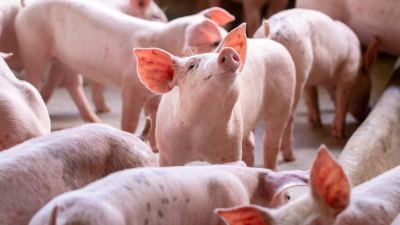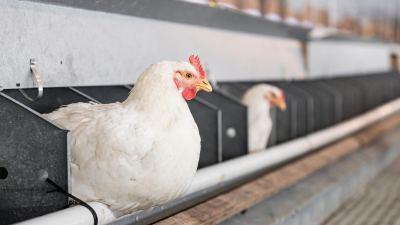Reducing antibiotics does not reverse antimicrobial resistance

World AMR Awareness Week (WAAW), celebrated every year from Nov. 18–24, is a global campaign to raise awareness and understanding of AMR and promote best practices to reduce the emergence and spread of drug-resistant pathogens. Photo courtesy of the World Health Organization
New research reaffirms Alltech’s long-standing findings that holistic control of resistant pathogens is key to combating AMR
In the century since antibiotics were invented, they have saved millions of lives. In recent years, though, these miracle medicines — along with antivirals and antifungals — have been rendered increasingly ineffective as microorganisms have evolved to resist them. This phenomenon is known as antimicrobial resistance (AMR).
To a certain extent, AMR happens naturally as microorganisms evolve. However, the speed and seriousness of the resistance seen in recent decades has made it clear that the process is being dangerously accelerated, likely due to the overuse and misuse of antibiotics among both humans and animals. In particular, decades of widespread antibiotic use in livestock production — not only to prevent health problems but to promote faster growth — has given harmful pathogens plenty of opportunities to develop resistance.
Because of AMR, infections once readily treatable are becoming persistent and even life-threatening. In 2019, according to the Food and Agriculture Organization of the United States, nearly 5 million human deaths worldwide were associated with bacterial AMR, of which 1.3 million were directly attributable to it. AMR is also causing serious damage in the global agri-food sector, with economic losses and drops in livestock production resulting in growing poverty, hunger and malnutrition.
Antibiotic removal not a “reset button”
When the dire implications of rising AMR first became evident, many scientists recommended the obvious solution: the reduction or elimination of antibiotics whenever possible.
But was this the only solution, or even the best solution?
Some researchers, including those at Alltech, decided to dig deeper.
First, they had to understand the extent of the problem. In an early study on the subject, in 1986, a University of Kentucky team — led by Dr. Karl Dawson, who later spent over 20 years as a research leader at Alltech and now serves as the company’s scientific advisor — studied multiple swine herds and found that antibiotic-resistant microflora that had developed from the use of antibiotics prior to 1972 were present in all of them. While the levels of AMR corresponded somewhat with the levels of antibiotic use in each herd, Dr. Dawson’s team found that some resistant microorganisms were present even in a herd where antibiotics had never been used at all. They also observed that resistance values stayed elevated even after antibiotics were discontinued in the herds. These findings were valuable in assessing the extent of the problem and the spread of AMR.
More recent research, by Dr. Richard Murphy’s team at the Alltech European Bioscience Centre, has expanded on these findings, confirming that while antibiotic reduction or discontinuation can be valuable in preventing future resistance, it does not reverse resistance that has already occurred. Most of the resistant microorganisms studied by Dr. Murphy’s team — including the pathogens of highest concern for human health, such as E. coli, Salmonella and Campylobacter — simply did not become sensitive to antibiotics again, even after those antibiotics had been reduced or eliminated for some time.
The science was clear: The removal of antibiotics is not an automatic “reset button” for resistant bacteria.
Support grows for new strategies
As research continues worldwide, the tide is turning toward this point of view, with solutions being developed that approach the problem holistically.
Most recently, a team at the University of Oxford in the U.K. has released findings that align with Alltech’s. An Oct. 6 article by Phys.org quotes Professor Tim Walsh, director of biology at the Ineos Oxford Institute and co-author of the paper: “Simply put, it is not enough to reduce antibiotic consumption in order to effectively combat antibiotic resistance. We need urgent and innovative approaches to combat antibiotic resistance, and strategies to protect our last-resort antibiotics for when we need them most.”
Dr. Murphy expects more researchers to publish studies with similar conclusions over the next 12 to 18 months. Slowly, the world is coming around to a better understanding of the limits of antibiotic reduction and elimination in addressing the AMR challenge.
Enhancing gut health through microbial diversity
But if removing antibiotics won’t work to gain back the ground we’ve lost to AMR, what will? And how can the agri-food community find ways to support animal health without antibiotic intervention?
Over more than four decades at the forefront of agricultural science, Alltech has built a wide and effective range of nutritional solutions by harnessing the power of yeast fermentation. In exploring whether this approach can be applied to the problem of AMR, Alltech researchers have successfully demonstrated the potential of using mannan-rich fraction (MRF), isolated from cell walls of Saccharomyces yeast, in controlling pathogens, including their resistant forms.
MRF stands out for its ability to enhance gut health by increasing microbial diversity. This diversity is crucial because it helps the gut self-regulate, making it more resilient when pathogens are encountered. As a result, pathogens are less likely to colonize the gastrointestinal tract and cause harm. Additionally, MRF influences the metabolism of pathogens such as E. coli, leading to an increase in those pathogens’ sensitivity to antibiotics.
In essence, it turns out that MRF works in three complementary ways:
- making antibiotics less necessary
- boosting their efficiency when they are needed
- decreasing the prevalence of resistant bacteria
But MRF, however effective, is only one tool in the toolbox of a widely effective, resilient answer to the AMR issue. Others include expertly crafted feed enzymes, functional nutrients, probiotics, organic minerals, and other yeast cell wall derivatives, such as mannan oligosaccharides (MOS).
Putting these solutions into practice
Equally important to the efficiency of these solutions is how and when they are administered. The Alltech path to antibiotic-free production begins with its innovative Seed, Feed, Weed program, which:
- Seeds the animal’s gut with probiotic bacteria, enhancing the body’s natural ability to fight off pathogens such as Salmonella or Campylobacter before they can cause problems
- Feeds the helpful bacteria with a safe organic acid that reduces pH within the gut, making it still less favorable for the growth of pathogens
- Weeds out harmful bacteria through the administration of yeast MRF prebiotics, even after those bacteria are well established in the gut
“If you can expand the richness and the diversity of the gut microflora, that enables the GI tract to self-police,” Dr. Murphy says. “You tend to get greater resistance to pathogen colonization of the GI tract.”
Once a thriving, healthy microbiome has been established, the animal has a foundation for health that includes optimized nutritional uptake and a stronger immune system. These qualities fill the needs for growth and disease control that antibiotics used to fill, but in a more natural and sustainable way.
The power of a holistic approach
The critical takeaway is that addressing AMR requires a multifaceted approach. As Dr. Murphy says, there is no “silver bullet.” While reducing unnecessary antibiotic use is an essential step, pathogen-control strategies must extend beyond mere antibiotic restrictions to encompass measures that target both the pathogens and their resistant variants.
By adopting innovative solutions like MRF and focusing on truly holistic pathogen control, the world can take substantial steps toward reducing the prevalence of resistant bacteria and safeguarding public health on a global scale.
Related content
Planet of Plenty™ fact page — Reducing antibiotic and antimicrobial resistance
Podcast — Antimicrobial Resistance: What You Need to Know
Blog — Reducing disease without increased antimicrobial resistance
Blog — FAO raises awareness to deadly consequences of antimicrobial resistance
















